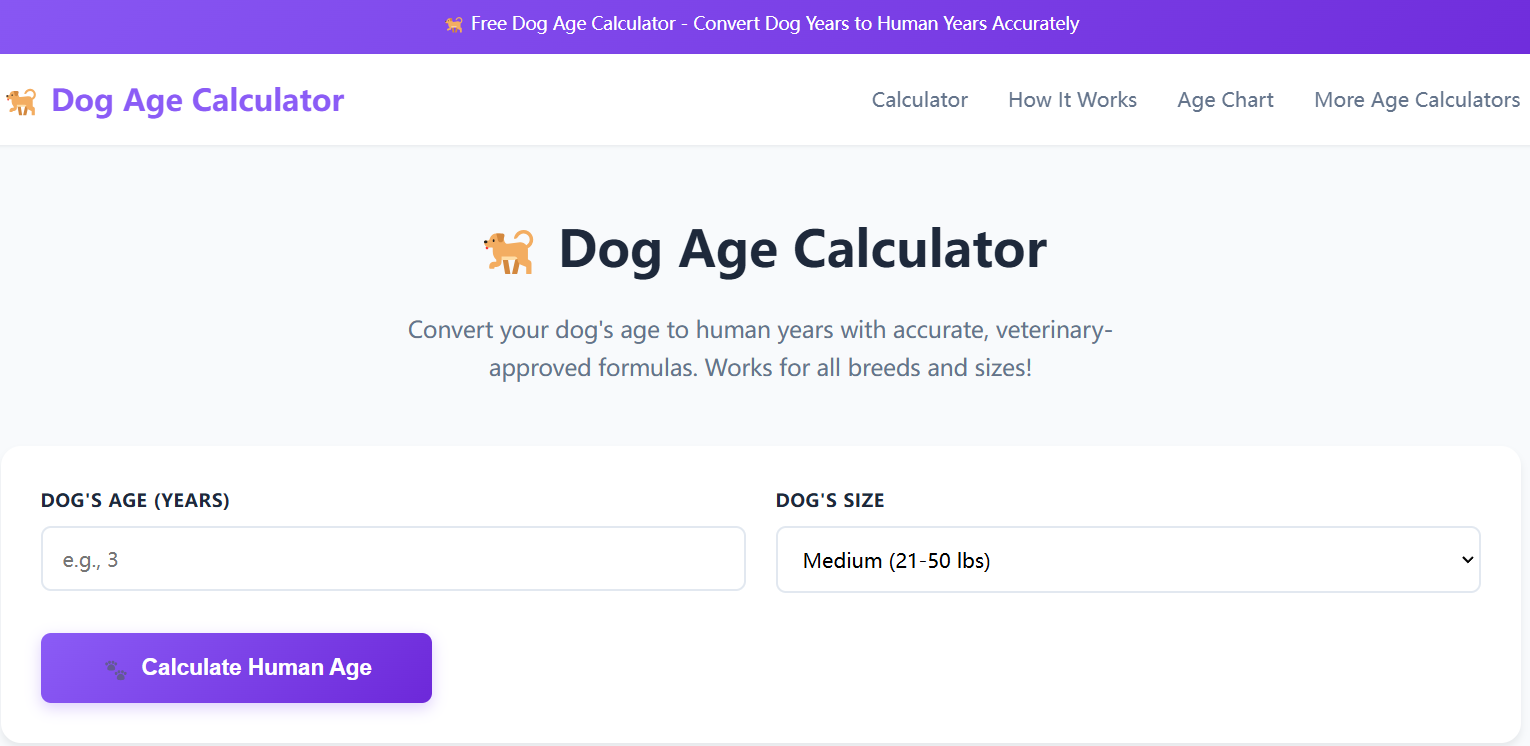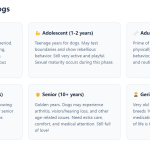Understanding your dog’s life stages is essential for providing optimal care throughout their lifetime. Just like humans, dogs go through distinct developmental phases, each with unique physical, behavioral, and nutritional needs. This comprehensive guide will help you navigate every stage of your dog’s life and ensure they receive the best possible care at every age.

Dog Age Calculator
The Six Life Stages of Dogs
Dogs typically progress through six main life stages, though the timing can vary significantly based on breed size. Smaller breeds tend to mature faster and live longer, while larger breeds age more quickly.
Stage 1: Neonatal Period (0-2 Weeks)
What to Expect
The neonatal period is the most vulnerable time in a puppy’s life. Newborn puppies are completely dependent on their mother, born with their eyes and ears closed. They spend approximately 90% of their time sleeping and the remaining time nursing.
Key Developments
- Limited mobility—puppies can only crawl
- Rely entirely on mother for warmth, nutrition, and stimulation
- No ability to regulate body temperature
- Begin developing their sense of touch and taste
Care Guidelines
If you’re caring for newborn puppies, maintain a warm environment (85-90°F), ensure the mother is healthy and well-fed, and monitor puppies’ weight gain daily. Consult a veterinarian immediately if puppies appear weak, fail to nurse, or don’t gain weight.
Stage 2: Transitional Period (2-4 Weeks)
What to Expect
This brief but crucial stage marks rapid sensory and motor development. Puppies’ eyes begin to open around day 10-14, and their ear canals open shortly after. They start to become aware of their surroundings and littermates.
Key Developments
- Eyes and ears open, responding to light and sound
- First teeth begin to emerge
- Start to walk and explore their environment
- Begin learning to eliminate on their own
- First socialization with littermates begins
Care Guidelines
Continue providing a safe, warm environment. Puppies still depend primarily on mother’s milk but may show interest in semi-solid food toward the end of this period. Gentle human interaction is beneficial but keep handling minimal and calm.
Stage 3: Socialization Period (4-12 Weeks)
What to Expect
This is arguably the most critical period for behavioral development. Puppies are highly impressionable and form lasting impressions about their world. Proper socialization during this window significantly impacts their adult temperament and behavior.
Key Developments
- Rapid learning and memory formation
- Weaning from mother’s milk (typically complete by 8 weeks)
- Primary vaccination series begins
- Fear periods may occur (brief phases of heightened fearfulness)
- Learning bite inhibition from littermates
- Critical period for socialization with people, other dogs, and various environments
Care Guidelines
Nutrition: Transition to high-quality puppy food formulated for their breed size. Feed 3-4 small meals daily.
Healthcare: Begin vaccination series (typically at 6-8 weeks) and schedule first veterinary checkup. Discuss deworming and parasite prevention.
Socialization: Expose puppies to various positive experiences—different people, gentle dogs, sounds, surfaces, and environments. Keep experiences positive and non-overwhelming.
Training: Begin basic handling exercises and introduce simple commands. Use positive reinforcement exclusively.
Stage 4: Juvenile Period (3-6 Months)
What to Expect
Often called the “teenage” phase, puppies become more independent, energetic, and sometimes challenging. They’re testing boundaries while still learning about their world. Teething occurs during this period as baby teeth fall out and adult teeth come in.
Key Developments
- Increased independence and confidence
- Teething discomfort and increased chewing behavior
- Continued rapid growth
- Sexual maturity begins (varies by breed)
- May test boundaries and display selective hearing
- Attention span increases
Care Guidelines
Nutrition: Continue puppy food, transitioning to 2-3 meals daily. Adjust portions as they grow.
Healthcare: Complete vaccination series and discuss spaying/neutering with your veterinarian. Many dogs are altered around 6 months, though timing varies by breed and individual factors.
Training: Enroll in puppy training classes. Establish consistent rules and routines. Redirect chewing to appropriate toys. Continue socialization efforts.
Exercise: Provide age-appropriate physical activity—avoid over-exercising growing puppies, especially large breeds, to protect developing joints.
Stage 5: Adolescence (6-18 Months)
What to Expect
Adolescence duration varies significantly by breed size. Small breeds may reach maturity by 10-12 months, while giant breeds may not fully mature until 18-24 months. This period brings continued behavioral challenges as dogs navigate hormonal changes and increasing independence.
Key Developments
- Reaching adult height (though may continue filling out)
- Sexual maturity fully established if not spayed/neutered
- May challenge established rules and boundaries
- Increased confidence, sometimes leading to reactivity or over-arousal
- Adult teeth fully developed
- Energy levels peak
Care Guidelines
Nutrition: Begin transitioning to adult food around 12 months for small breeds, 12-15 months for medium breeds, and 15-18 months for large/giant breeds. Consult your veterinarian for specific timing.
Healthcare: Maintain regular veterinary checkups and stay current on vaccinations, heartworm prevention, and flea/tick control.
Training: Remain consistent with training. Adolescent dogs may regress in behaviors they previously mastered—stay patient and continue reinforcement. Consider advanced training classes.
Exercise: Provide adequate physical exercise and mental stimulation. Adolescent dogs have substantial energy requiring productive outlets.
Stage 6: Adulthood (1-7 Years, Varies by Size)
What to Expect
Adulthood is the longest life stage, though its duration depends heavily on breed size. Small breeds might be considered adults from 1-10 years old, while giant breeds may be seniors by age 6. Adult dogs are typically calmer, more predictable, and settled into their personalities.
Key Developments
- Physically mature and fully grown
- Personality fully developed
- Stable energy levels (generally lower than adolescence)
- Established behavioral patterns
- Peak physical condition (approximately 1-5 years)
Care Guidelines
Nutrition: Feed high-quality adult maintenance food appropriate for their size, activity level, and any health conditions. Most adults do well with two meals daily.
Healthcare: Schedule annual wellness examinations. Maintain dental care through regular teeth brushing and professional cleanings as recommended. Continue parasite prevention year-round. Monitor weight carefully—obesity is a major health concern for adult dogs.
Exercise: Provide daily physical activity appropriate to breed and individual energy levels. Most dogs benefit from 30-120 minutes of exercise daily.
Mental Stimulation: Continue training, provide puzzle toys, and maintain social interactions to keep your dog mentally engaged.
Stage 7: Senior Years (7+ Years, Varies by Size)
What to Expect
Senior status arrives at different ages depending on size: small breeds around 10-12 years, medium breeds around 8-10 years, large breeds around 6-8 years, and giant breeds as early as 5-6 years. Senior dogs experience gradual physical and cognitive changes requiring adjusted care.
Key Developments
- Decreased energy levels and activity
- Graying around the muzzle and face
- Possible vision and hearing decline
- Arthritis and joint stiffness common
- Potential cognitive decline (canine cognitive dysfunction)
- Increased sleep requirements
- Possible changes in appetite or weight
- Greater susceptibility to illness
Care Guidelines
Nutrition: Transition to senior-formulated food with appropriate calorie levels. Many seniors require fewer calories but higher-quality protein. Consider supplements for joint health (glucosamine, omega-3s) as recommended by your veterinarian.
Healthcare: Increase veterinary visits to twice yearly. Senior wellness screenings should include blood work, urinalysis, and other diagnostic tests to catch age-related diseases early. Common senior health issues include arthritis, dental disease, kidney disease, heart disease, and cancer.
Exercise: Continue regular exercise but adjust intensity and duration. Gentle walks, swimming, and low-impact activities help maintain mobility and mental health. Monitor for signs of pain or discomfort.
Comfort: Provide orthopedic bedding, maintain comfortable indoor temperatures, and ensure easy access to food, water, and outdoor areas. Consider ramps or steps for accessing furniture or vehicles.
Mental Health: Keep your senior dog mentally stimulated with gentle training, new experiences, and social interaction while respecting their need for more rest.
Factors Affecting Life Stage Timing
Breed Size
Size is the most significant factor determining life stage progression:
- Toy and Small Breeds (under 20 lbs): Mature quickly, longer lifespans (12-16+ years)
- Medium Breeds (20-50 lbs): Moderate maturation and lifespans (10-14 years)
- Large Breeds (50-90 lbs): Slower maturation, shorter lifespans (8-12 years)
- Giant Breeds (90+ lbs): Slowest maturation, shortest lifespans (6-10 years)
Other Factors
- Genetics: Breed-specific health issues and longevity
- Nutrition: Quality diet throughout life supports healthy aging
- Healthcare: Preventive care and prompt treatment of illnesses
- Exercise: Appropriate activity levels maintain health and mobility
- Environment: Safe, stimulating, low-stress environments promote wellbeing
- Spay/Neuter Status: May affect longevity and certain health conditions
General Care Tips for All Life Stages
Nutrition Principles
- Choose high-quality food appropriate for life stage and size
- Maintain healthy body condition—obesity shortens lifespan
- Provide fresh water at all times
- Avoid toxic foods (chocolate, grapes, onions, xylitol, etc.)
Healthcare Essentials
- Establish a relationship with a trusted veterinarian
- Keep vaccinations current based on lifestyle and risk factors
- Maintain year-round parasite prevention (heartworm, fleas, ticks)
- Practice regular dental care
- Monitor for changes in behavior, appetite, or physical condition
Training and Socialization
- Use positive reinforcement methods exclusively
- Begin training and socialization early
- Maintain consistency throughout life
- Continue mental stimulation at every age
- Respect your dog’s individual personality and limitations
Exercise and Enrichment
- Provide daily physical activity appropriate to age and ability
- Offer mental stimulation through training, puzzles, and exploration
- Adjust activities as your dog ages
- Monitor for signs of overexertion or discomfort
Recognizing When Your Dog Transitions Between Stages
Watch for these signs that your dog is moving into a new life stage:
Entering Adulthood: Calmer behavior, less destructive chewing, better impulse control, stable energy patterns
Entering Senior Years: Gray hair, decreased activity, sleeping more, stiffness after rest, slower movement, reluctance to jump or climb stairs
Advanced Senior: Significant mobility issues, confusion or disorientation, house-soiling accidents, decreased interest in activities they once enjoyed
Understanding your dog’s life stages empowers you to provide appropriate, proactive care throughout their lifetime. Each stage brings unique joys and challenges. By recognizing the specific needs of each phase—from the dependent newborn puppy to the dignified senior dog—you can ensure your canine companion enjoys the healthiest, happiest life possible.
Remember that these stages are guidelines, and individual dogs may progress differently based on their unique characteristics. Regular veterinary care, attentive observation, and adaptation to your dog’s changing needs are the keys to supporting them through every wonderful stage of their life journey.
Always consult with your veterinarian about your individual dog’s needs, as they can provide personalized recommendations based on breed, health status, and lifestyle factors.




